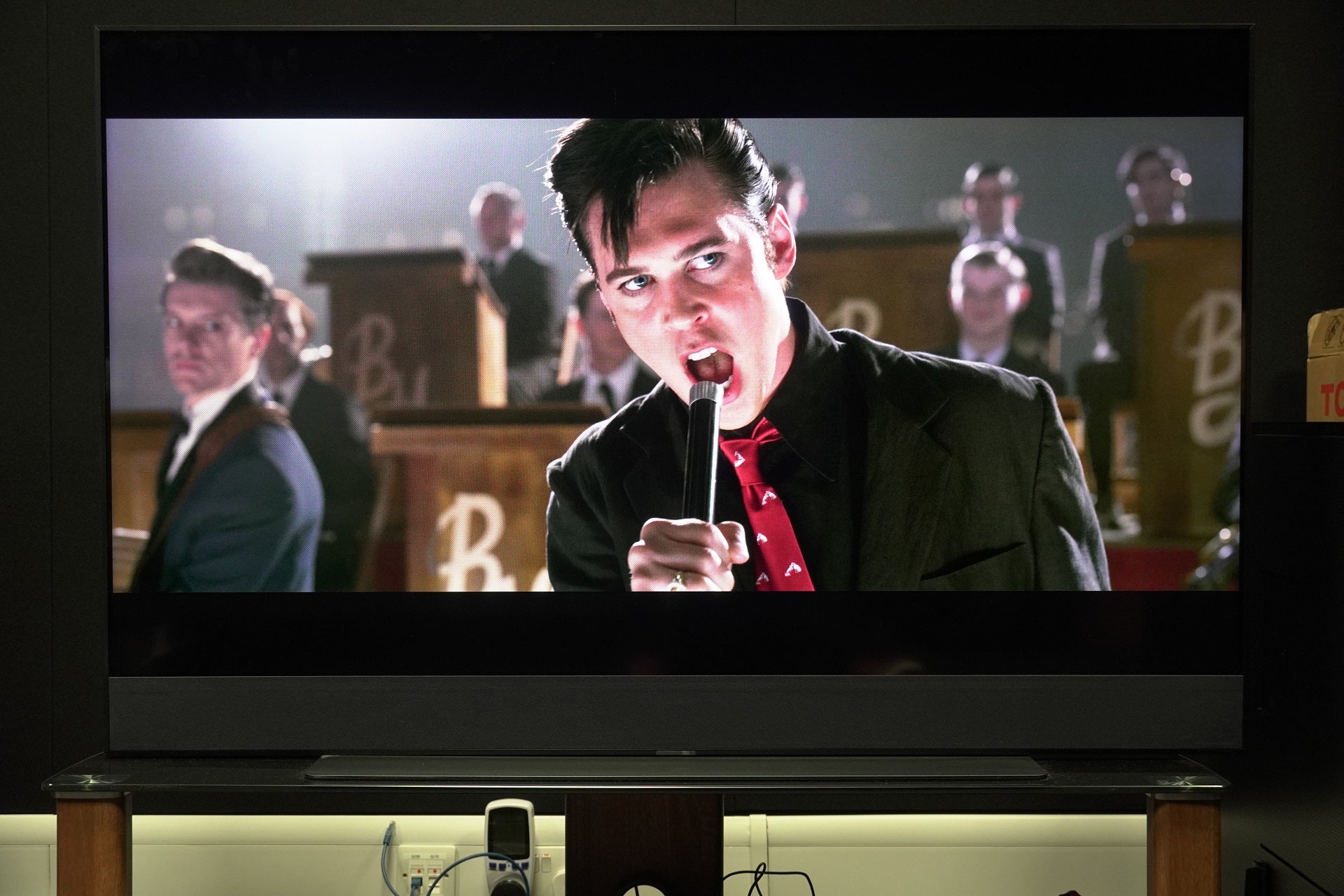Verdict
Consider Sky Glass for what it is rather than what it’s not and there’s a good experience to be had. The interface is greatly accessible, the Vivid mode improves the HDR performance, though the price has gone up. Sky Glass fulfils a bit more of its potential to earn a recommendation, but there are more talented sets available, especially where HDR is concerned.
Pros
- Great content library and interface
- Better sound than TVs at its price
- Stylish looks
- Vivid mode improves HDR performance
Cons
- Still some blooming and artefacts with content
- Expensive for the UHD/Atmos experience
- Needs plenty of bandwidth for all the features
Key Features
Introduction
Sky Glass is a TV designed to be easily digestible, smoothing out the rough edges of the TV buying experience by taking care of picture, sound, and content without the need for additional soundbars, set-top boxes or streaming sticks.
The initial reception was a mixed one, with an average HDR picture performance failing to take advantage of all the content on the Sky platform.
However, as this is designed to be hooked up to the Internet 24/7, Sky can focus on improving all aspects of its performance, and in early 2023 a new Vivid mode was added to nip those picture quality complaints in the bud. But is it enough?
Availability
- UKRRP: £949
- USAunavailable
- Europeunavailable
- Canadaunavailable
- Australiaunavailable
Sky Glass can be purchased directly from Sky in 43-, 55- and 65-inch options. The TV can be bought outright (£699, £949, and £1199); or monthly in 24- and 48-month instalments.
The cost, if you buy outright, has gone up in the last year. The 43-inch model costs £50 more, the 55-inch is £100 more expensive, and the 65-inch model has added £150 to its asking price.
Prices as of May 2023 are as low as £11/month + £25 for Sky TV and Netflix on a 48-month contract for the small size.
In terms of add-ons, customers can choose from the Ultra HDR and Atmos package to Sky Sports, Sky Cinema, multi-room, the Sky Stream puck and more. Though the costs rise even more if you do. You can read more about the packages here.
Design
- Big and heavy
- Minimalist looks
- Several colour options
From a head-on perspective Sky Glass looks elegant: its minimalist stand, thin bezel trim, anodised finish, and acoustic mesh speaker grille give it an understated, classy appearance.
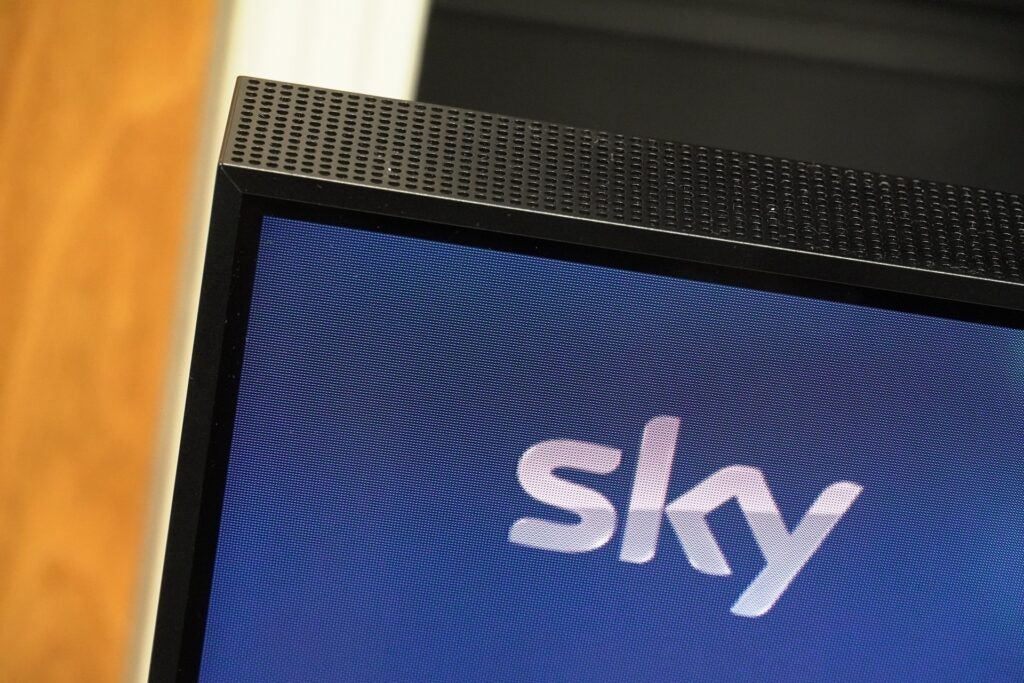
But in reality, that’s an illusion, as viewed from an angle and the Glass is a hefty unit with a depth of 477mm. The 55-inch model weighs 28kg including the stand, so it’s a relief that installation is performed by the courier service. Shift it on your own and you might put your back out.
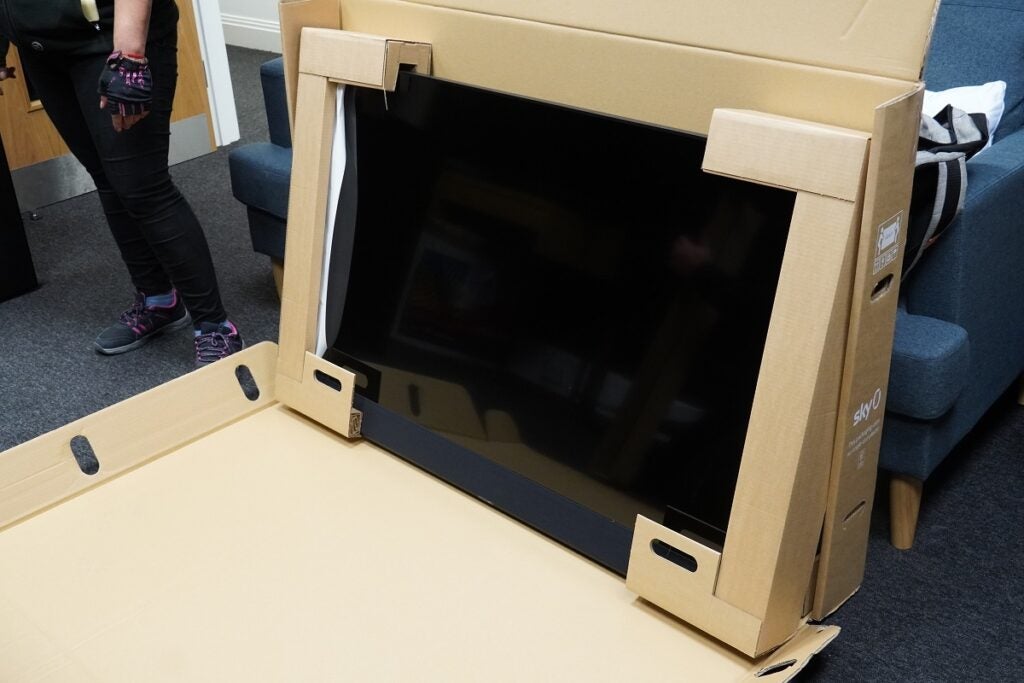
Irrespective of its dimensions, it’s attracted admiring glances from the Trusted Reviews’ team. The review sample is the black Anthracite version, but Sky Glass brings colour to a living room with a choice of Ocean blue, Ceramic white, Racing green and Dusky pink to match your décor.
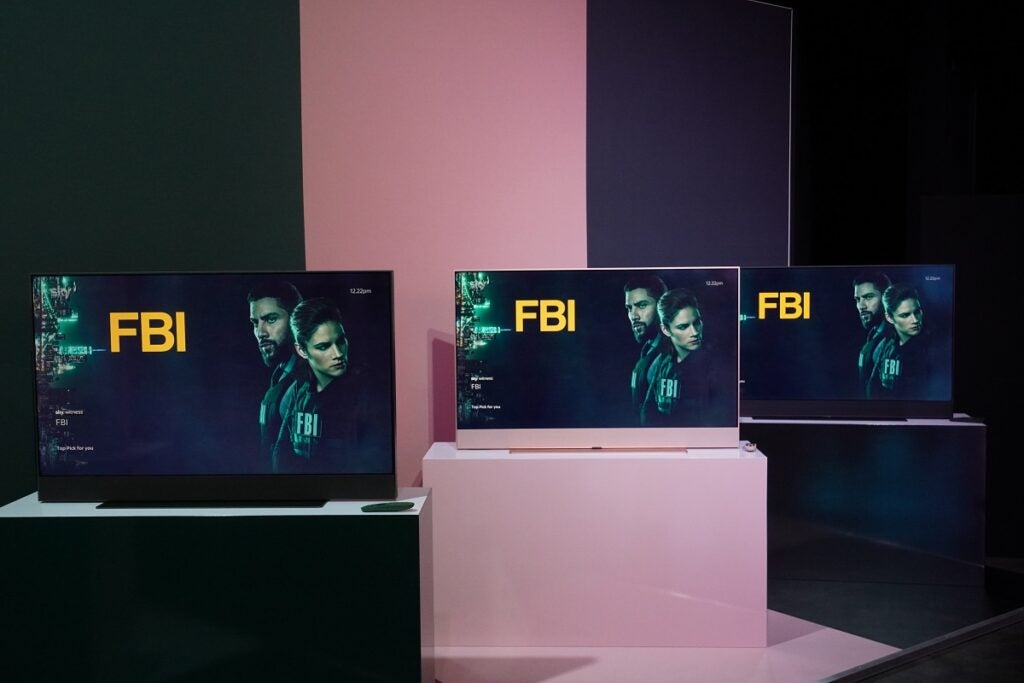
The speaker grille area can be customised with magnetised attachments, which can be purchased from Amazon seller Concino Limited (£39.99 to £59.99 depending on the size).
On the right-hand side are two buttons, one for disabling the TV’s far-field microphones and another for power. Cast your eyes to the top and there’s a perforated acoustic grille to disperse the sound from the upfiring speakers, while around the rear there’s a stanchion to keep the TV upright. If you want to wall-mount, give Sky a call and they’ll do it for you.
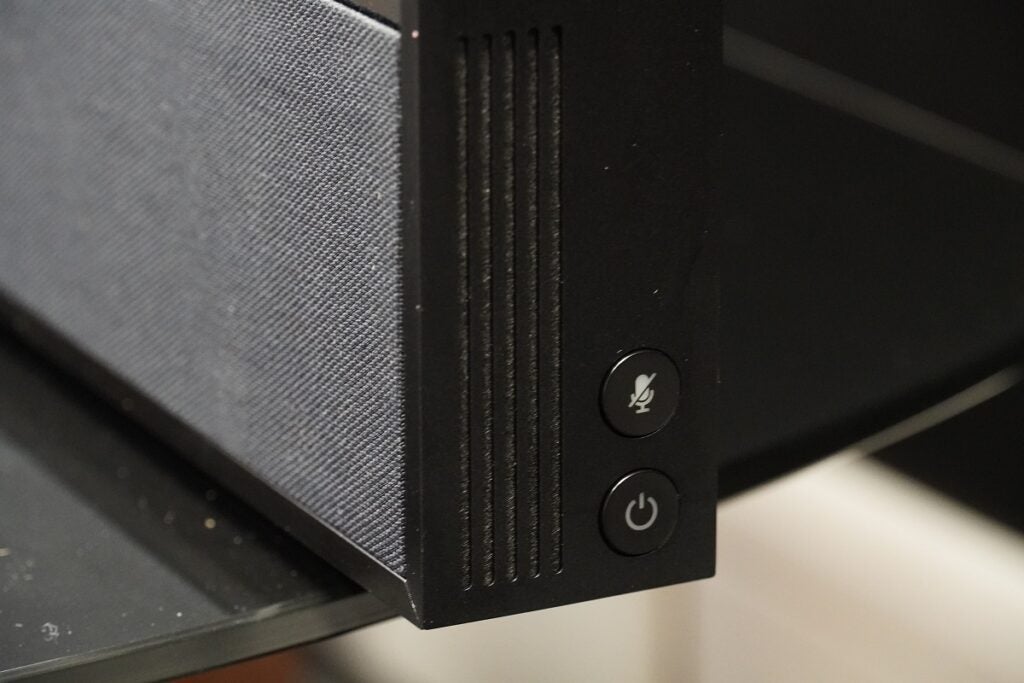
Entertainment OS interface
- Playlist collates saved content
- Easy to use interface
- Sky’s voice control solution
The Entertainment OS aggregates all that Sky has to offer alongside content from other providers. It uses the same rail navigation system as Sky Q, with the top rail offering quick access to recently used apps, inputs and spotlighted content in Top picks.
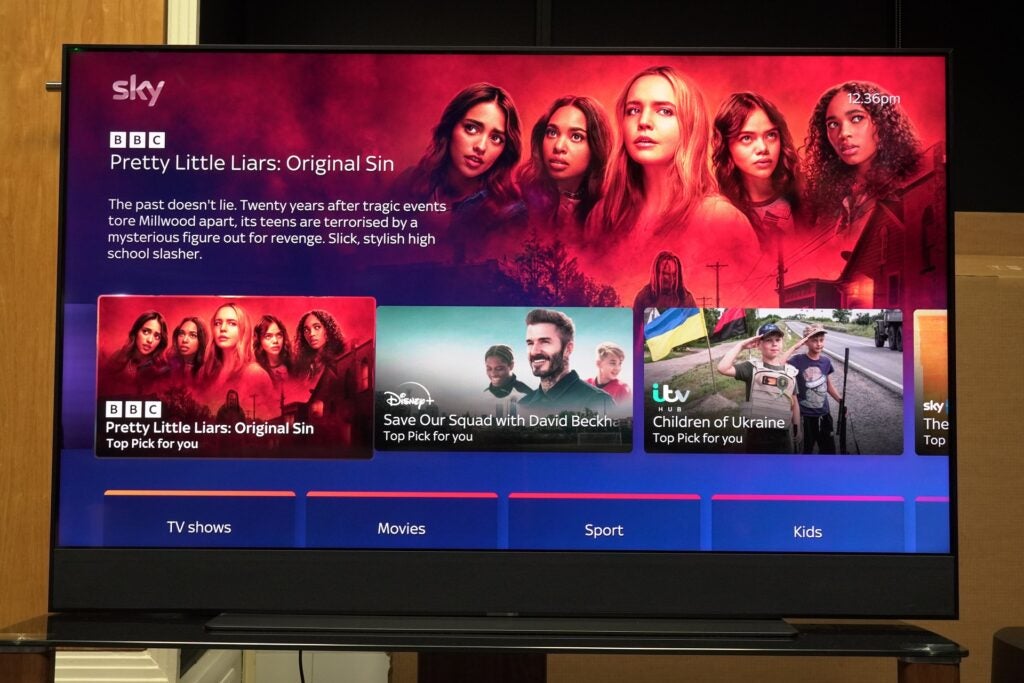
The rail below is divided into TV Shows, Movies, Sport, Kids, Audio and Music, News, Fitness and International. Each section keeps the same look, with content listed in rows and TV guides specific to each one. The breadth of content impresses, as does the way it’s been knitted together in a coherent, easy to decipher manner.
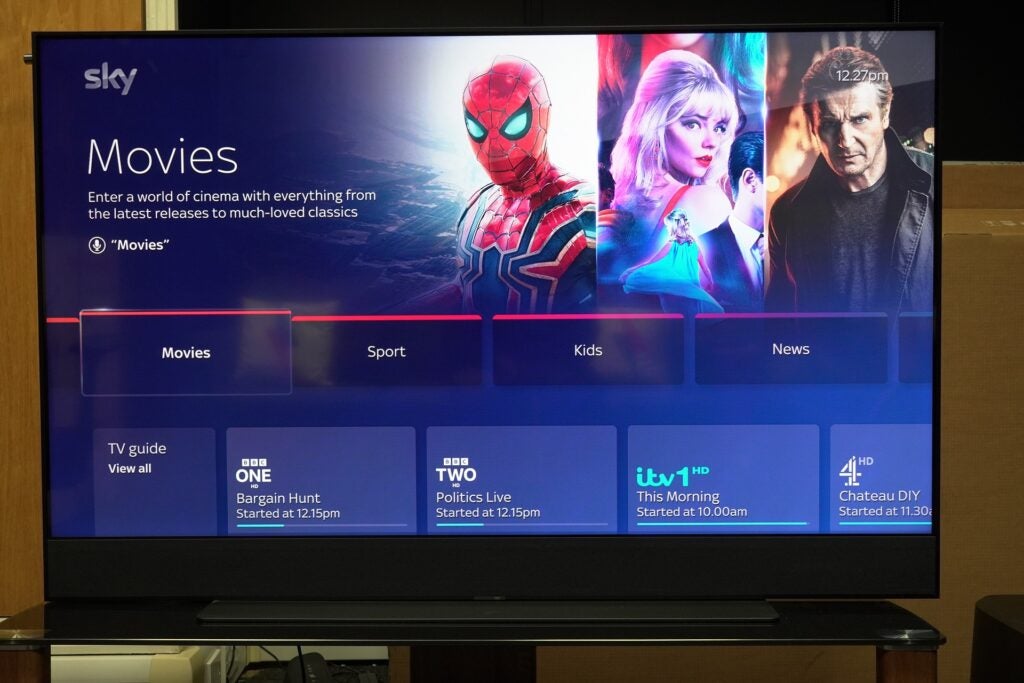
Most Sky Q apps make their way over, and while the number of apps is fewer than other TV smart portals, there’s something to be said about quality over quantity. Since Sky Glass launched its added Apple TV+, NBCUniversal’s Peacock, Paramount+ and LionsGate+.
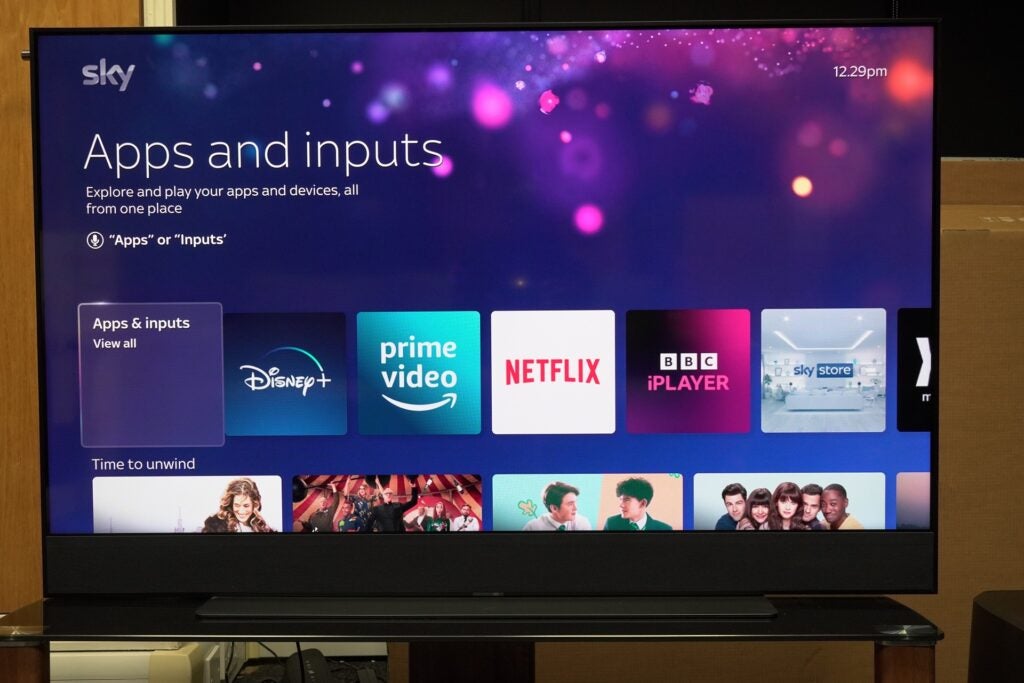
There’s plenty to discover and flicking through the rails with the remote is swift enough in terms of response. If you don’t want to use your digits, there’s built-in voice control initiated by the words ‘Hello Sky’. Initially voice control was flaky, but I’ve found it’s become faster and more receptive since launch, and search results have also improved in terms of their accuracy.
Voice support has been added to YouTube and Netflix so users can speak into the remote to find content, with Sky also saying that voice updates will be coming to more apps (although it hasn’t stated when and which apps).
Voice commands via the remote’s near-field mic don’t require the ‘Hello Sky’ prompt, and in general, voice control gets you to where you want or to what you’re looking for. At a loss for what to watch? Say “What should I watch?” and you’re served rows of recommended titles.
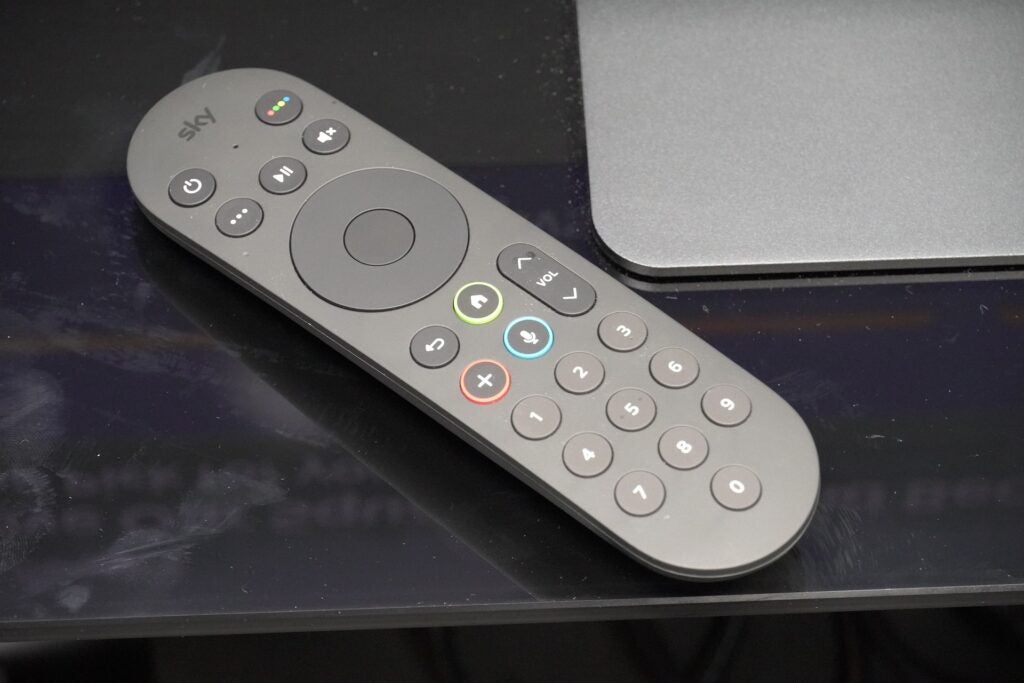
The remote itself is a neat affair with a rubbery texture for a grippy hold and backlit buttons for use in the dark. It attracts fingerprints and smudges, but they’re easily wiped off.
Sky refers to its Playlist feature as cloud DVR, but this has caused a degree of consternation as you can’t record content. It’s a means of collating all the content you’ve watched, are watching and plan to watch, and it’s a great way to keep track of shows and films. It’s had a few re-jigs with movies, TV shows and sports separated into their own rows.
However, for those who prefer to keep their titles permanently, or at least for several months, then that’s simply not possible due to rights issues. Once a programme has left Netflix, for example, access to that programme will disappear from your Playlist.
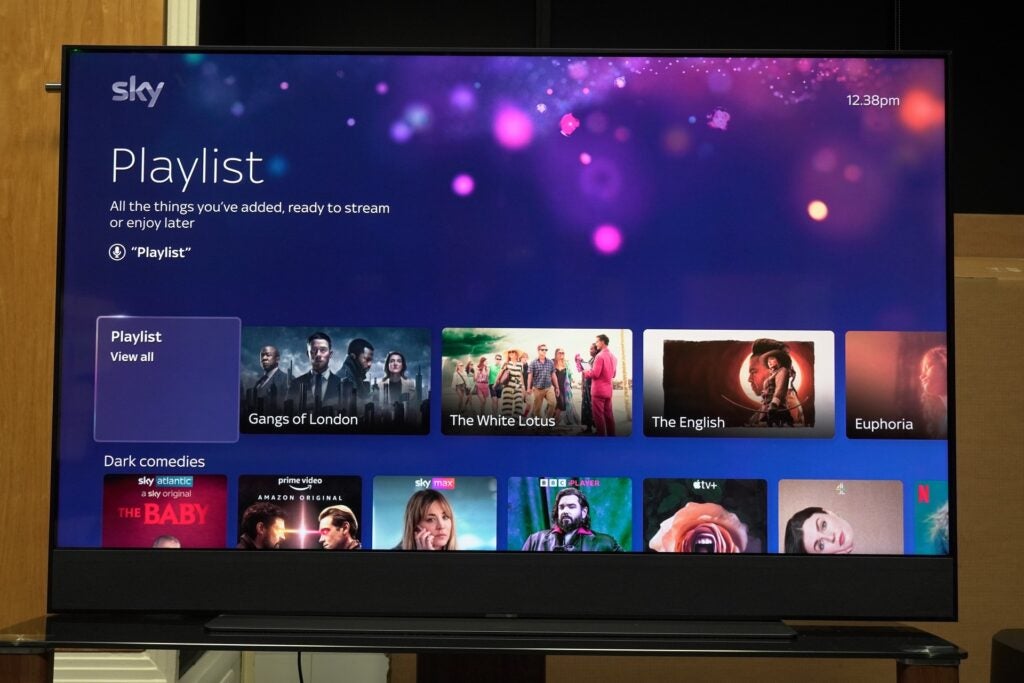
Sky’s counterargument is that nothing truly disappears but migrates to another service and while there’s an element of truth to that, the obvious issue is that what if it appears on Prime Video and you don’t have an account? Would you want to pay for it on Sky Store or sub to another service? One answer is to wait for the programme to come back, but who knows how long that will take. There are a few holes in Sky’s approach.
You also can’t add content to Playlist directly from apps so a search must be performed, and you can add there. If you come across something of interest, then a press of the ‘+’ button on the remote adds it to your Playlist. It’s a nice and straightforward action.
Add a TV series to Playlist and it’ll string together all the seasons, regardless of the apps it’s spread over and if it’s not available elsewhere the Sky Store can fill the gap.
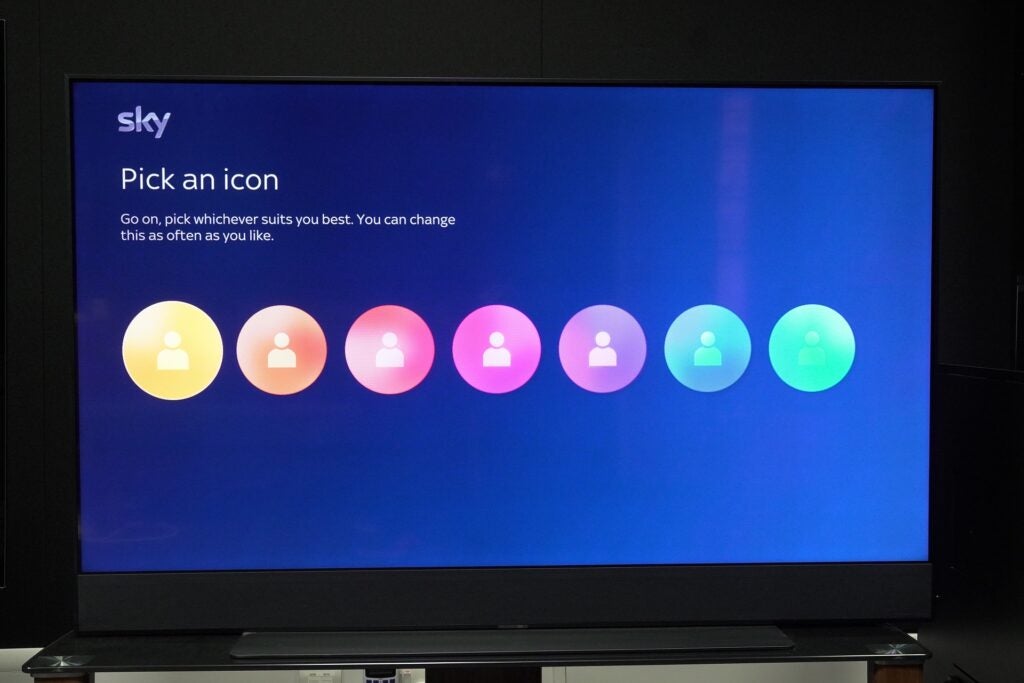
There are no individual profiles but personalised Playlists for different family members are available so you can view what you want rather than filtering through your kid’s tastes.
Where accessibility is concerned, Sky has incorporated the High Contrast interface, Audio description and highlighting of content in the TV Guide for easier recognition.
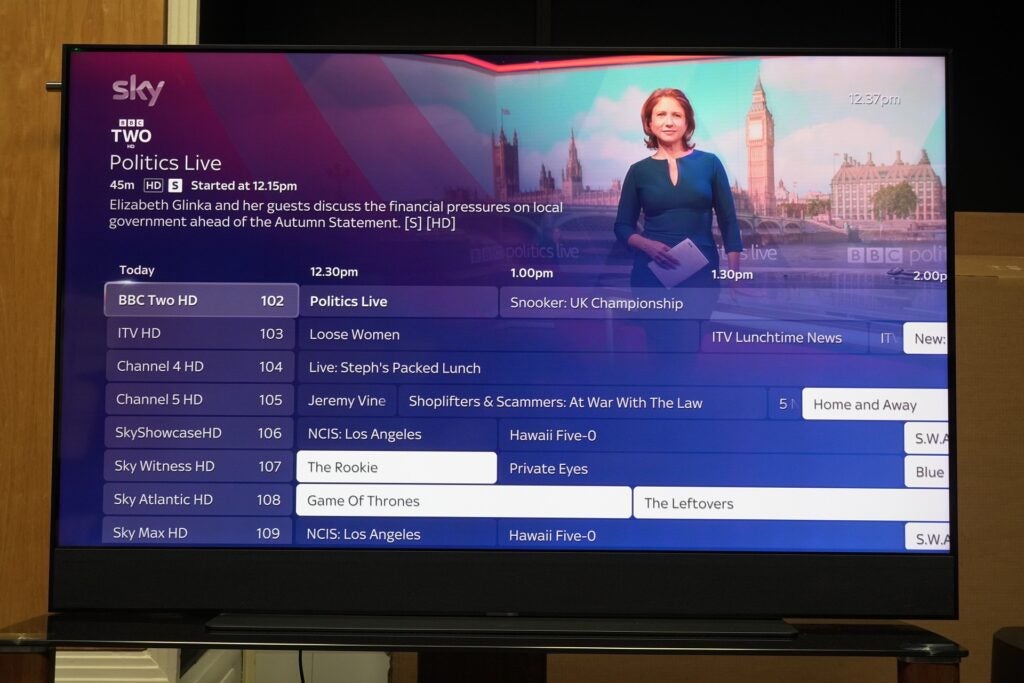
Features
- Not for gamers
- Minimum 10Mb/s for streaming
- Stream puck copies interface to other screens
There are things that Sky Glass is, and things that it’s not – and it’s not a gaming TV. Latency is a measly 66ms and with no Auto Low Latency Mode, 4K/120fps or Variable Refresh Rate, Sky Glass doesn’t play in the gaming sandpit.
The three HDMI inputs support the HDMI 2.1 spec, with HDMI 2 the eARC port for pass-through of higher quality audio to an external sound system. As Sky Glass has a built-in Atmos sound system, you could leave it at that if you wanted.
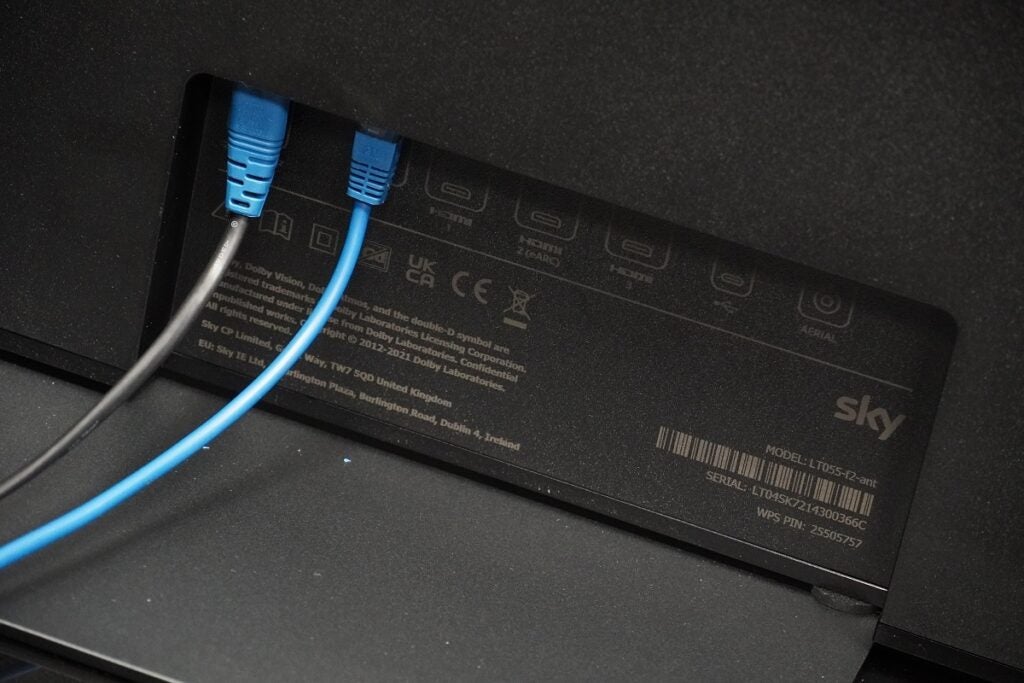
Other connections include USB-C, Ethernet, and a DTT DVB-T/T2 aerial. That offers basic Freeview and acts as a backup if the Internet goes down. There’s Bluetooth 5.0 (for the remote, and connecting other devices) and Wi-Fi 6. Sky Glass requires a minimum speed of 10Mb/s (25Mb/s for 4K Ultra HD).
During start-up you’re given a choice of Default or Enhanced experiences. Enhanced activates voice control and the instant wake-up features, so the TV can be turned on via voice or by walking past, though it’s not the most consistent in behaviour.
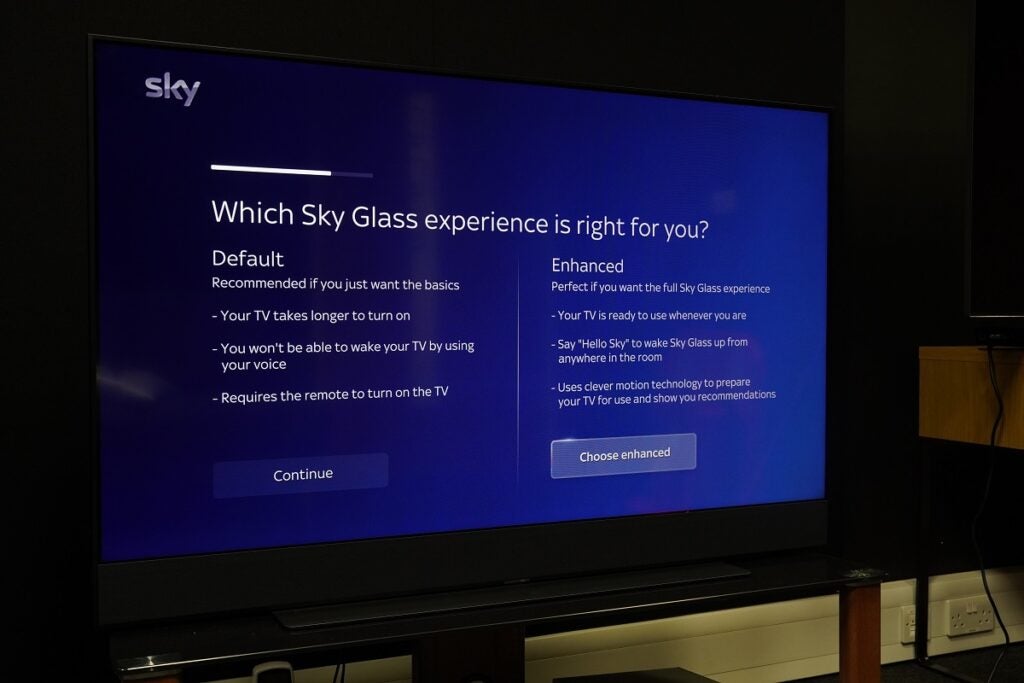
I’ve walked past it plenty of times and nothing has happened. Other times I’ve sat down on the couch to see it’s woken up. Waking it with your voice is more consistent and since launch the TV is quicker in the time it takes to boot.
I wasn’t supplied with the Sky Stream puck for the Glass review, but it exists independently of Glass and is now available to buy as a standalone device – you can read what I thought of it here. Stream uses around 15Mb/s to stream content within the home.
Sky Glass also supports an interactive smart camera that was revealed at its launch party, but it hasn’t been heard since. Expect news about it in the summer of 2023.
Picture Quality
- Not the sharpest image
- Improved brightness and colours with Vivid mode
- Lacklustre viewing angles
At launch, Sky Glass’s picture quality was no disaster, but it was not unreasonable to expect better given quality of content on its service.
The HDR performance suffered from a lack of brightness. I measured brightness with a 5% HDR window on the 55-inch model at 430 nits. That’s not quite at the level needed to see the potential of HDR. Sky has since added a Vivid more to spruce up the TV’s performance, and it does produce a much better level of brightness with HDR content, hitting 566 nits on 5% window and 670 nits on a 10% window. Now that is more like it.
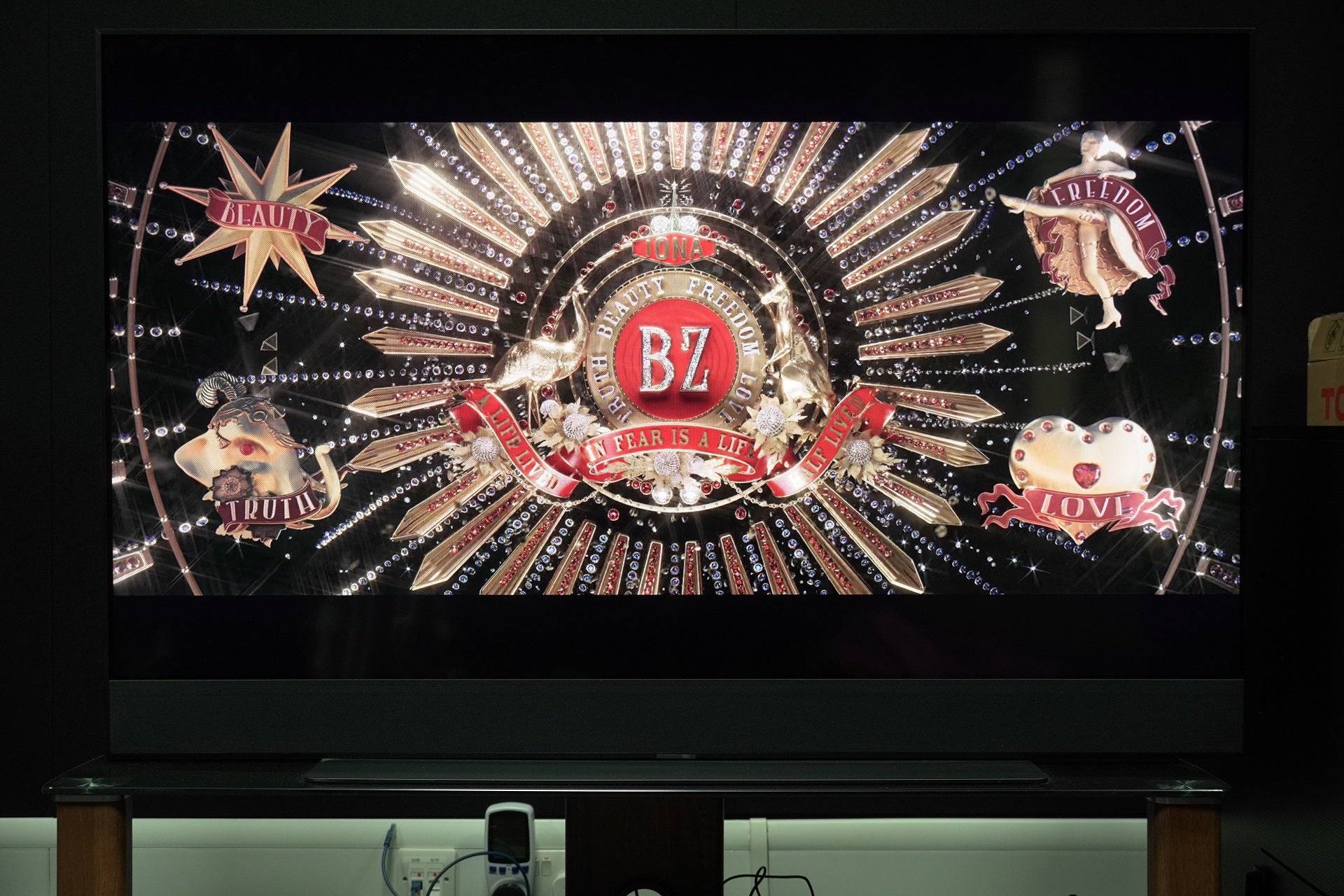
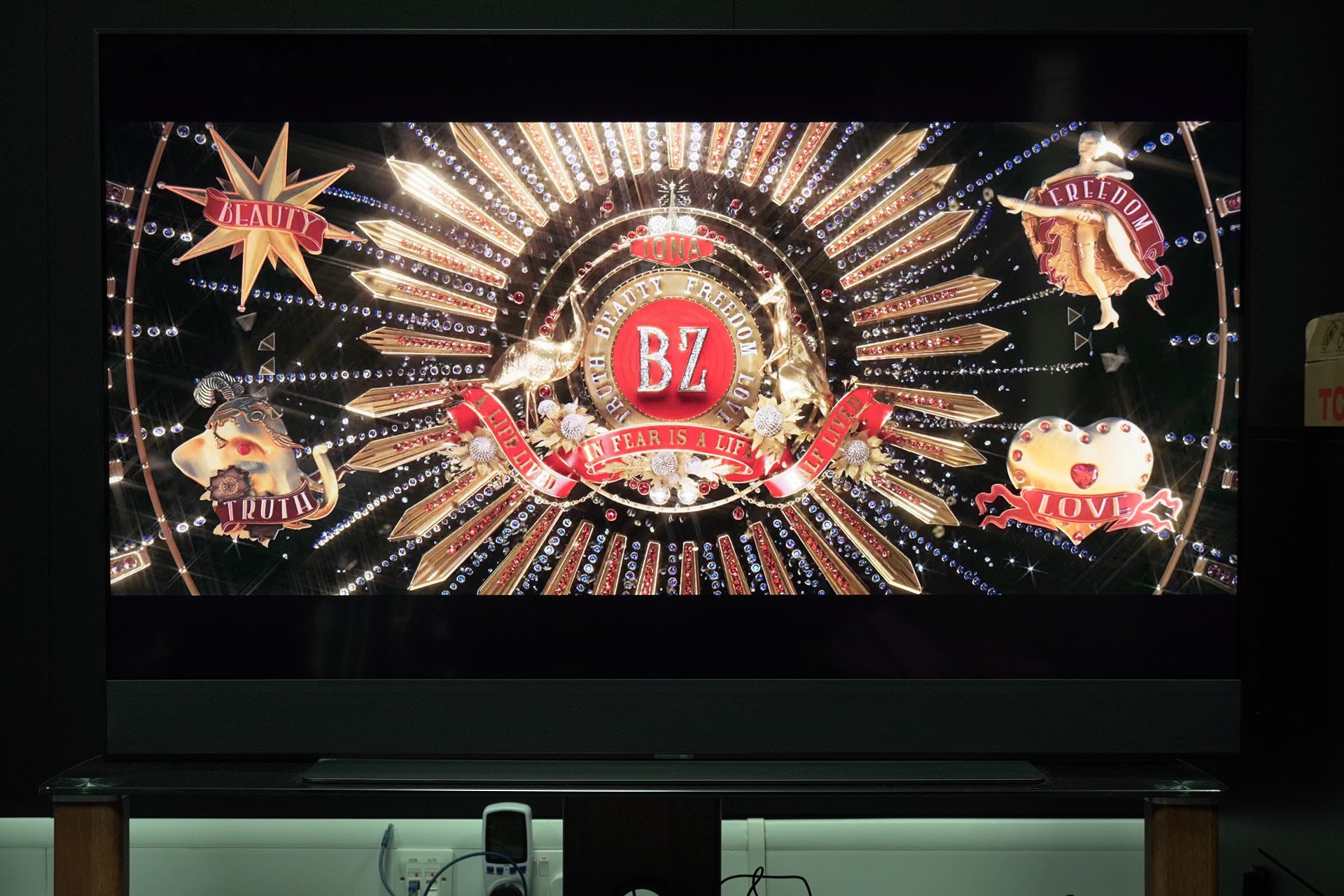
The Vivid mode certainly adds more colour and saturation to images, to the point where it makes the Movie preset look drab and restrained by comparison. I can see most clearly in the striking opening credits of Elvis – reds are bolder in their appearance and the golds actually look golden.
Blacks also have more depth, complexions are amped up too, taking on a more orange/reddish skin tone but it is more colourful. I’d describe the Movie preset as the most accurate and the Vivid mode as the most entertaining.
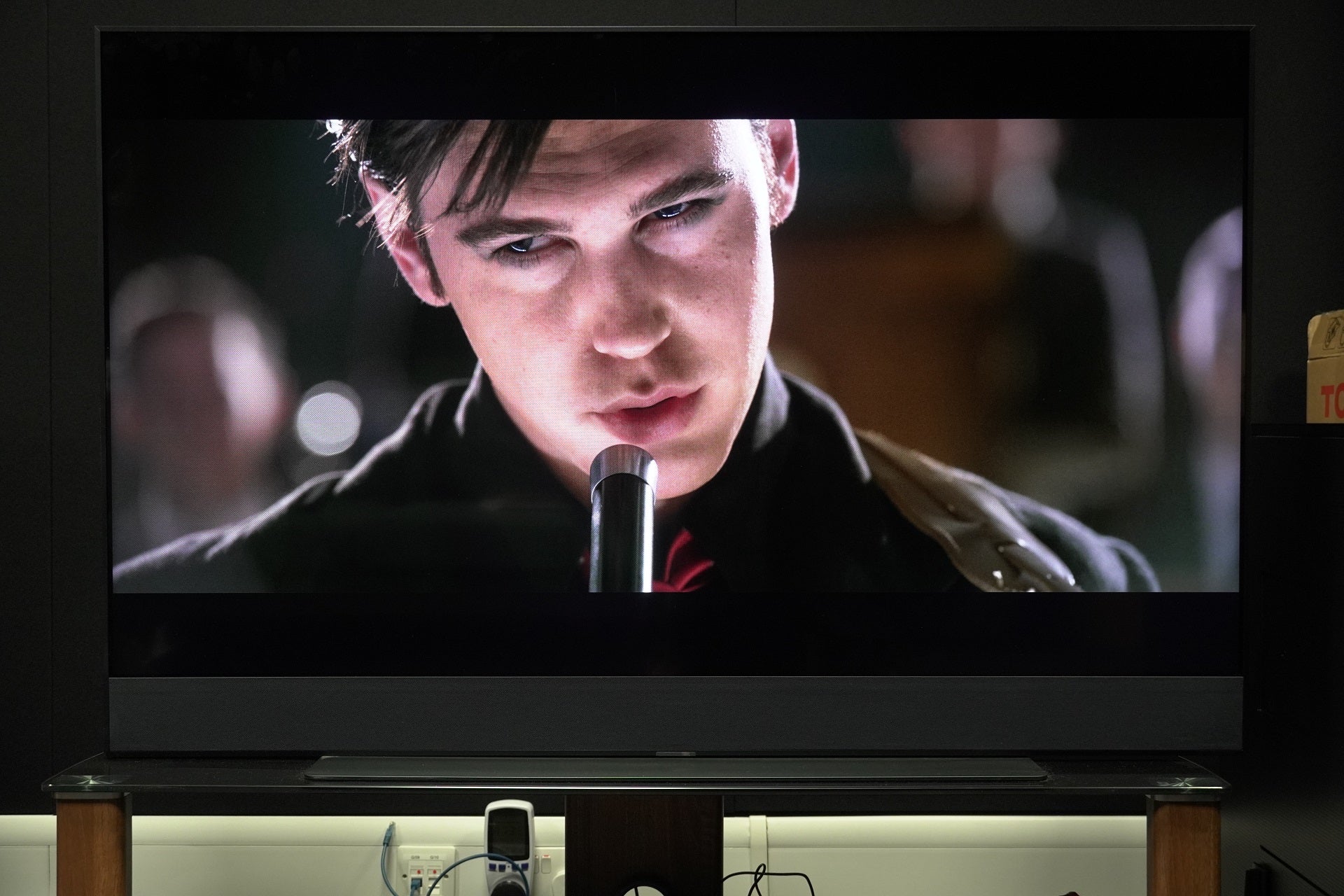
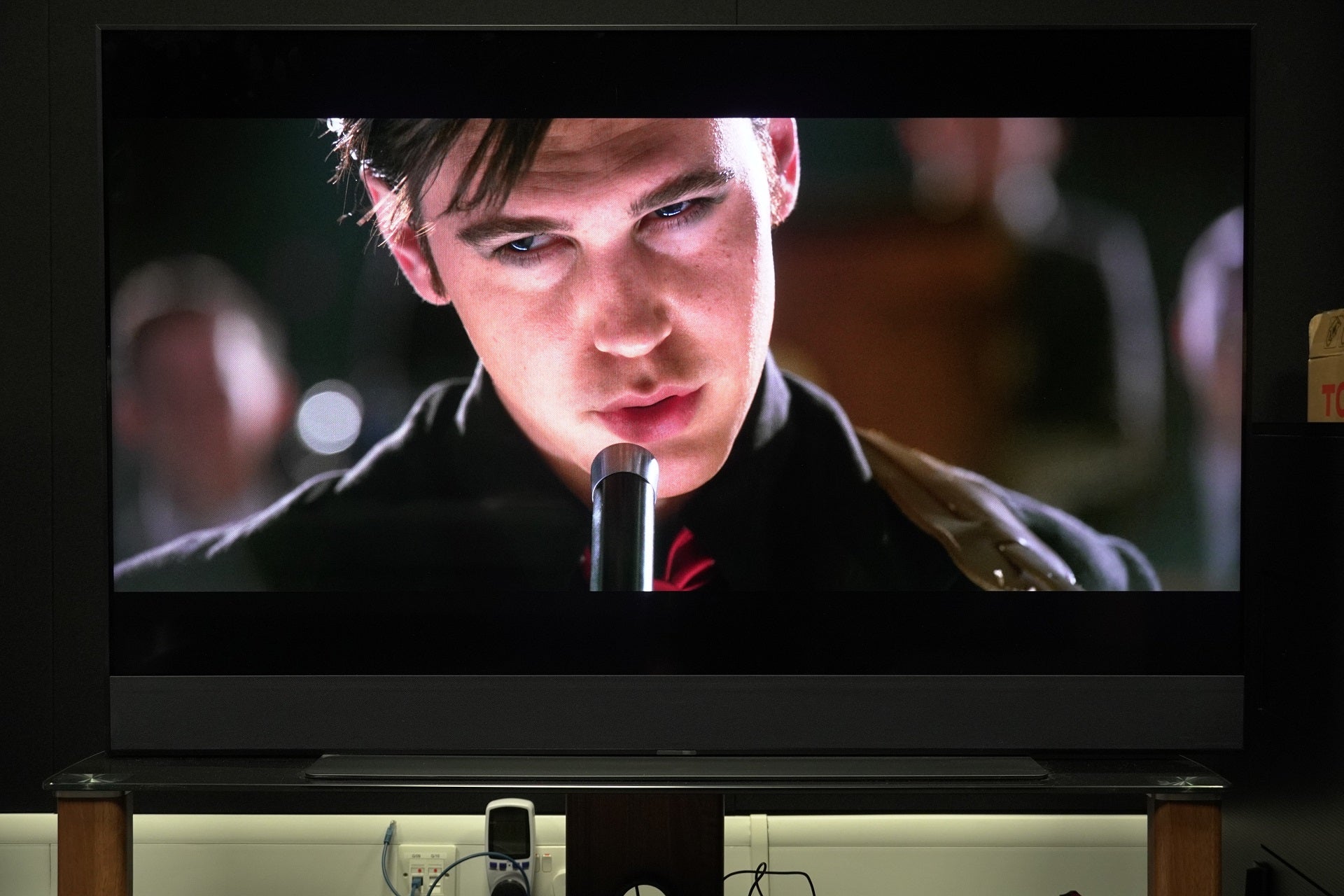
There’s less blooming noticeable with the Vivid mode too, though the problem hasn’t gone away completely. There are still traces of it in the opening scene of House of the Dragon’s first episode that continue into the credits, and the visibility of the blooming depends on where you’re sitting (at wider angles it’s more noticeable).
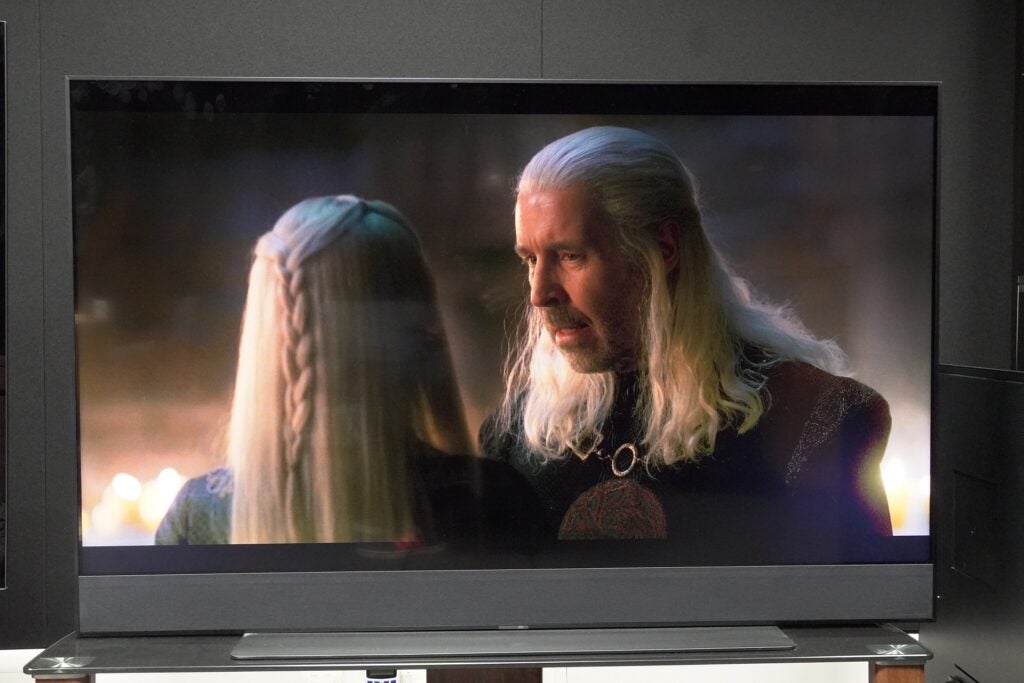
Black levels can also look a little green in dark scenes that litter Dune and House of the Dragon, and again that’s an issue that becomes more noticeable at wider angles.
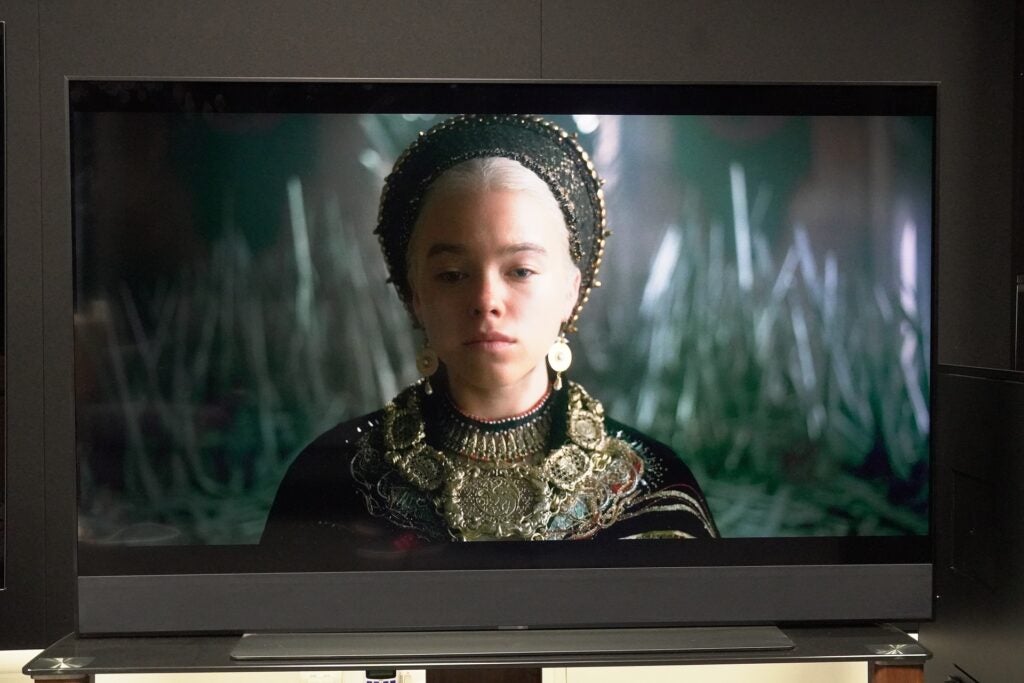
Despite that, the performance improvements only apply to the Vivid mode and don’t affect the others. Playing John Wick Chapter 3 on 4K Blu-ray with Dolby Vision, when Wick visits Angelica Huston’s The Director, there’s still elements of blooming with bright objects. Movie, Entertainment, Sports, and the other modes haven’t received a similar boost as the Vivid mode. There are also some odd artefacts with bright objects against darker backgrounds that manifest themselves in Dune.
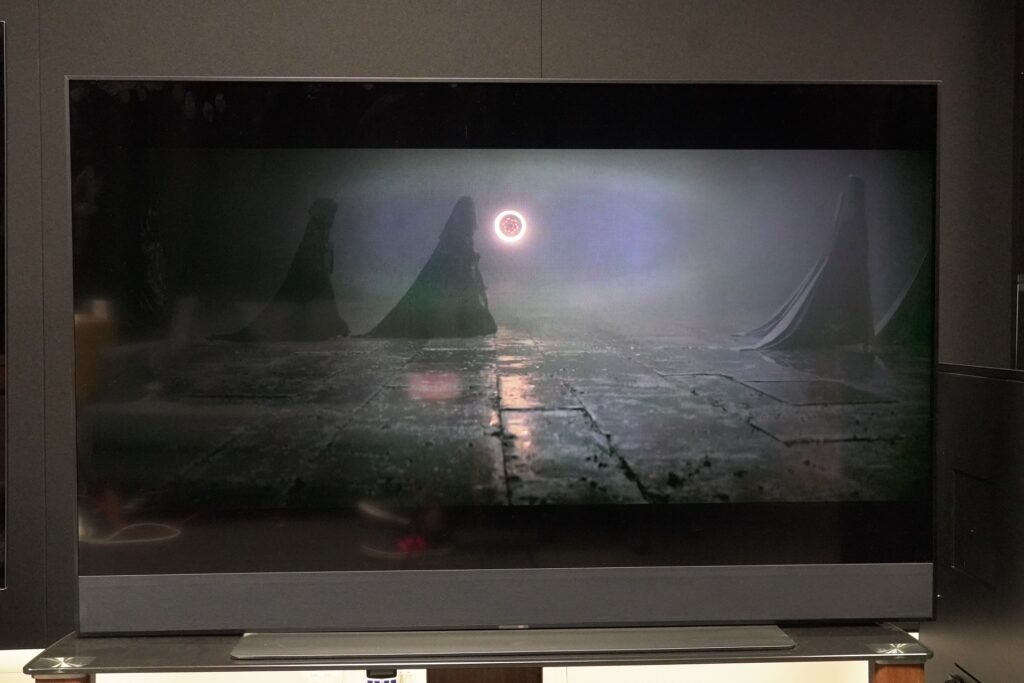
A strength of LCD TVs is dark detail and Sky Glass handles that aspect well enough for a revealing picture, though this is more apparent with brighter images. Black uniformity is fine, avoiding a washed-out appearance and ascribing a decent level of depth. However, with every bit of praise there’s a caveat. Viewing angles are average and it doesn’t take a big shift off-axis to reveal washed out colours and blooming, not helped by TV not dealing particularly well with reflections and glare from within a room.
HD streaming/upscaling is decent, at times sharp and clear enough to pick out fine detail but in others it produces a softness to faces, as well as hardness and shininess to edges that distracts. Reducing sharpness helps but finding a middle ground is tricky. Motion handling isn’t the most adept either, with a slight blurriness noticeable even when people turn their heads.
Sound Quality
- Decent, punchy bass for a TV
- Polite impression of height channels
- A soundbar would offer better focus
The first sample I received had a faulty woofer that caused distortion with the mildest of low-end frequencies, but the replacement has been free from issues.
Sky Glass’ 215W Dolby Atmos system is made up of six speakers: three that fire audio at the listener, two that fire up and a woofer that covers the low frequencies. It’s an improvement over other TVs in its price bracket, putting in a solid, weighty, and spacious presentation. Is it better than a budget soundbar? No, but this 2.1 system will suffice for the less demanding.
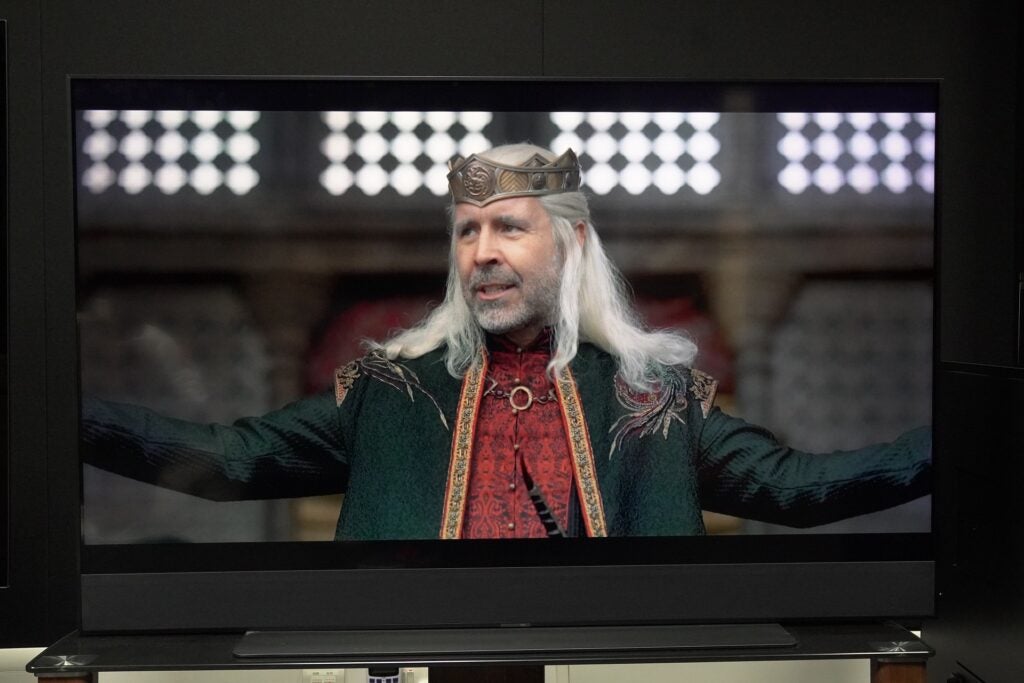
Vocals are emphasised, though not quite naturally, especially when two voices speak at once. Pump up the volume and voices have a sharp sense of tone but avoid sibilance. The effect of the Enhance Speech Quality setting is most evident on Sky content, with voices more prominent but the naturalness of the delivery a little stifled.
Effects are steered across the screen well, creating a soundfield that spreads beyond the TV’s four corners. The scene in Tenet where The Protagonist is interrogated in a train yard as the trains creak past and the width of the soundstage is effectively expanded beyond the TV’s borders.
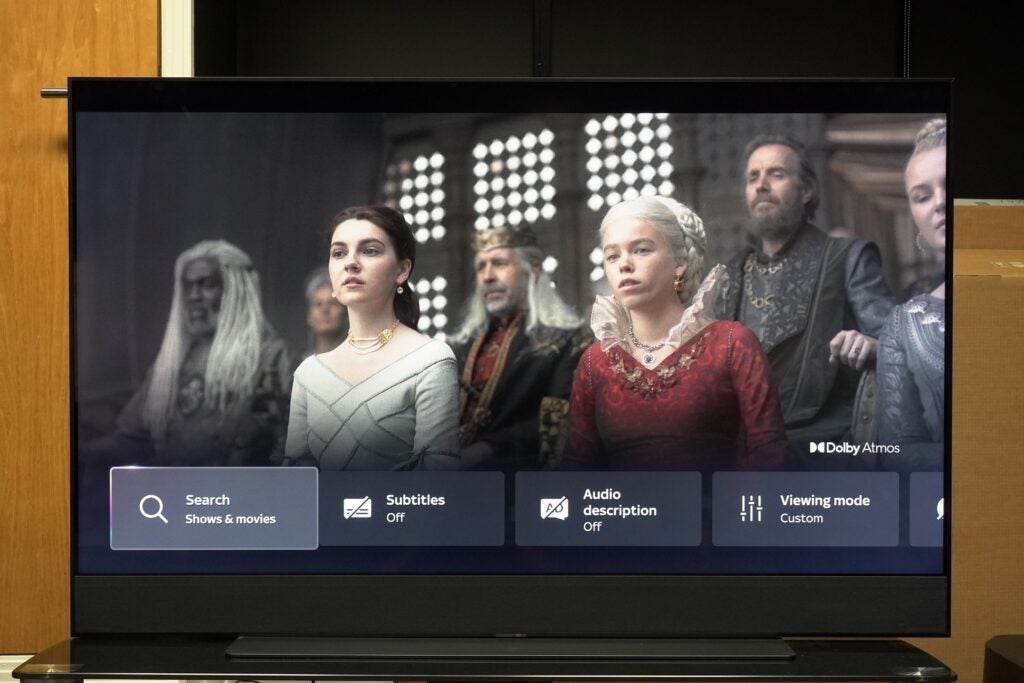
High frequencies have clarity (if not overall sharpness), and bass is punchy though lacks real low-end authority, with impact sounds (punches, gunshots) softly described. Even so, this is better than most TVs.
And with Atmos there’s a tall reach to the Glass’ sound in Blade Runner 2049 as Spinner cars and futuristic advertisements sit above and around the TV. An Atmos soundbar would evoke better definition, but compared to other TVs around its price, this is an improvement.
Latest deals
Should you buy it?
For Sky customers who want a simplified TV experience: Sky Glass distils the TV experience into a streamlined form in a way that hasn’t been attempted.
If you are after best picture and sound: Despite the improved picture, there are more capable 2022 TVs, even more so now the price has gone up.
Final Thoughts
In terms of streamlining the TV experience, there’s plenty to laud about Sky Glass, and steady improvements have been made to turn Sky Glass into a TV that can be recommended – just about.
It’s clear that this isn’t trying to be an OLED or premium QLED, although the Vivid more does reap more performance from HDR content. It’s enough now that it’s overall performance can be considered worthy of a recommendation, but I still have the feeling that Glass’s picture leaves some potential on the table.
And while it’s not a premium TV, add everything up and the subscription model still incurs a premium price, even more so now that all the model sizes have gone up in price. A cheaper option is Sky Stream for those who’d prefer to just add a streamer to the existing TV.
How we test
We test every television we review thoroughly over an extended period of time. We use industry standard tests to compare features properly. We’ll always tell you what we find. We never, ever, accept money to review a product.
Find out more about how we test in our ethics policy.
FAQs
Sky says a minimum of 10Mb/s is required for the Glass TV. Minimum download speed for UHD is 25Mb/s.
At its cheapest option, the 43-inch Sky Glass TV plus the Sky Ultimate TV package costs £36/month.
Sustainability
Trusted Reviews’ holds the fact that global warming is not a myth as a core value and will continuously endeavour to help protect our planet from harm in its business practices.
As part of this mission, whenever we review a product we send the company a series of questions to help us gauge and make transparent the impact the device has on the environment.
We currently haven’t received answers to the questions on this product, but will update this page the moment we do. You can see a detailed breakdown of the questions we ask and why in our sustainability info page.
Jargon buster
QLED
QLED stands for Quantum-dot Light Emitting Diode. It’s a display technology that uses small particles (called Quantum Dots) made up of slightly different sizes that produce different wavelengths (colours) when light is shone through them. This filter helps to emit a brighter and wider gamut of colours than a conventional LED TV is capable of.
Dolby Vision
Dolby Vision is a variant of HDR, adding a layer of dynamic metadata to the core HDR signal. This dynamic metadata carries scene-by-scene (or frame-by-frame) instructions from content creators on how a TV should present the images to improve everything from brightness to contrast, detailing and colour reproduction.
4K Ultra HD TV
4K (or Ultra HD) refers to the resolution of a TV’s display, which equates to the number of horizontal and vertical pixels that it can display. 4K TVs have a resolution of 3840 x 2160 (8.3 million pixels), which is four times that of a Full HD TV. With more pixels, you get a sharper, clearer picture than is possible from an equivalent sized 1080p display.
Dolby Atmos
Dolby Atmos is an object-based audio format. It expands on 5.1 and 7.1 soundtracks by adding overhead channels. Sounds are referred to as “audio objects”, of which there can be up to 128 audio channels, and these ‘objects’ can be accurately positioned within a 3D soundscape. This allows soundtracks that support the technology to place sounds above and around the listener with compatible kit.
Verdict
Consider Sky Glass for what it is rather than what it’s not and there’s a good experience to be had. The interface is greatly accessible, the Vivid mode improves the HDR performance, though the price has gone up. Sky Glass fulfils a bit more of its potential to earn a recommendation, but there are more talented sets available, especially where HDR is concerned.
Pros
- Great content library and interface
- Better sound than TVs at its price
- Stylish looks
- Vivid mode improves HDR performance
Cons
- Still some blooming and artefacts with content
- Expensive for the UHD/Atmos experience
- Needs plenty of bandwidth for all the features
Key Features
Introduction
Sky Glass is a TV designed to be easily digestible, smoothing out the rough edges of the TV buying experience by taking care of picture, sound, and content without the need for additional soundbars, set-top boxes or streaming sticks.
The initial reception was a mixed one, with an average HDR picture performance failing to take advantage of all the content on the Sky platform.
However, as this is designed to be hooked up to the Internet 24/7, Sky can focus on improving all aspects of its performance, and in early 2023 a new Vivid mode was added to nip those picture quality complaints in the bud. But is it enough?
Availability
- UKRRP: £949
- USAunavailable
- Europeunavailable
- Canadaunavailable
- Australiaunavailable
Sky Glass can be purchased directly from Sky in 43-, 55- and 65-inch options. The TV can be bought outright (£699, £949, and £1199); or monthly in 24- and 48-month instalments.
The cost, if you buy outright, has gone up in the last year. The 43-inch model costs £50 more, the 55-inch is £100 more expensive, and the 65-inch model has added £150 to its asking price.
Prices as of May 2023 are as low as £11/month + £25 for Sky TV and Netflix on a 48-month contract for the small size.
In terms of add-ons, customers can choose from the Ultra HDR and Atmos package to Sky Sports, Sky Cinema, multi-room, the Sky Stream puck and more. Though the costs rise even more if you do. You can read more about the packages here.
Design
- Big and heavy
- Minimalist looks
- Several colour options
From a head-on perspective Sky Glass looks elegant: its minimalist stand, thin bezel trim, anodised finish, and acoustic mesh speaker grille give it an understated, classy appearance.

But in reality, that’s an illusion, as viewed from an angle and the Glass is a hefty unit with a depth of 477mm. The 55-inch model weighs 28kg including the stand, so it’s a relief that installation is performed by the courier service. Shift it on your own and you might put your back out.

Irrespective of its dimensions, it’s attracted admiring glances from the Trusted Reviews’ team. The review sample is the black Anthracite version, but Sky Glass brings colour to a living room with a choice of Ocean blue, Ceramic white, Racing green and Dusky pink to match your décor.

The speaker grille area can be customised with magnetised attachments, which can be purchased from Amazon seller Concino Limited (£39.99 to £59.99 depending on the size).
On the right-hand side are two buttons, one for disabling the TV’s far-field microphones and another for power. Cast your eyes to the top and there’s a perforated acoustic grille to disperse the sound from the upfiring speakers, while around the rear there’s a stanchion to keep the TV upright. If you want to wall-mount, give Sky a call and they’ll do it for you.

Entertainment OS interface
- Playlist collates saved content
- Easy to use interface
- Sky’s voice control solution
The Entertainment OS aggregates all that Sky has to offer alongside content from other providers. It uses the same rail navigation system as Sky Q, with the top rail offering quick access to recently used apps, inputs and spotlighted content in Top picks.

The rail below is divided into TV Shows, Movies, Sport, Kids, Audio and Music, News, Fitness and International. Each section keeps the same look, with content listed in rows and TV guides specific to each one. The breadth of content impresses, as does the way it’s been knitted together in a coherent, easy to decipher manner.

Most Sky Q apps make their way over, and while the number of apps is fewer than other TV smart portals, there’s something to be said about quality over quantity. Since Sky Glass launched its added Apple TV+, NBCUniversal’s Peacock, Paramount+ and LionsGate+.

There’s plenty to discover and flicking through the rails with the remote is swift enough in terms of response. If you don’t want to use your digits, there’s built-in voice control initiated by the words ‘Hello Sky’. Initially voice control was flaky, but I’ve found it’s become faster and more receptive since launch, and search results have also improved in terms of their accuracy.
Voice support has been added to YouTube and Netflix so users can speak into the remote to find content, with Sky also saying that voice updates will be coming to more apps (although it hasn’t stated when and which apps).
Voice commands via the remote’s near-field mic don’t require the ‘Hello Sky’ prompt, and in general, voice control gets you to where you want or to what you’re looking for. At a loss for what to watch? Say “What should I watch?” and you’re served rows of recommended titles.

The remote itself is a neat affair with a rubbery texture for a grippy hold and backlit buttons for use in the dark. It attracts fingerprints and smudges, but they’re easily wiped off.
Sky refers to its Playlist feature as cloud DVR, but this has caused a degree of consternation as you can’t record content. It’s a means of collating all the content you’ve watched, are watching and plan to watch, and it’s a great way to keep track of shows and films. It’s had a few re-jigs with movies, TV shows and sports separated into their own rows.
However, for those who prefer to keep their titles permanently, or at least for several months, then that’s simply not possible due to rights issues. Once a programme has left Netflix, for example, access to that programme will disappear from your Playlist.

Sky’s counterargument is that nothing truly disappears but migrates to another service and while there’s an element of truth to that, the obvious issue is that what if it appears on Prime Video and you don’t have an account? Would you want to pay for it on Sky Store or sub to another service? One answer is to wait for the programme to come back, but who knows how long that will take. There are a few holes in Sky’s approach.
You also can’t add content to Playlist directly from apps so a search must be performed, and you can add there. If you come across something of interest, then a press of the ‘+’ button on the remote adds it to your Playlist. It’s a nice and straightforward action.
Add a TV series to Playlist and it’ll string together all the seasons, regardless of the apps it’s spread over and if it’s not available elsewhere the Sky Store can fill the gap.

There are no individual profiles but personalised Playlists for different family members are available so you can view what you want rather than filtering through your kid’s tastes.
Where accessibility is concerned, Sky has incorporated the High Contrast interface, Audio description and highlighting of content in the TV Guide for easier recognition.

Features
- Not for gamers
- Minimum 10Mb/s for streaming
- Stream puck copies interface to other screens
There are things that Sky Glass is, and things that it’s not – and it’s not a gaming TV. Latency is a measly 66ms and with no Auto Low Latency Mode, 4K/120fps or Variable Refresh Rate, Sky Glass doesn’t play in the gaming sandpit.
The three HDMI inputs support the HDMI 2.1 spec, with HDMI 2 the eARC port for pass-through of higher quality audio to an external sound system. As Sky Glass has a built-in Atmos sound system, you could leave it at that if you wanted.

Other connections include USB-C, Ethernet, and a DTT DVB-T/T2 aerial. That offers basic Freeview and acts as a backup if the Internet goes down. There’s Bluetooth 5.0 (for the remote, and connecting other devices) and Wi-Fi 6. Sky Glass requires a minimum speed of 10Mb/s (25Mb/s for 4K Ultra HD).
During start-up you’re given a choice of Default or Enhanced experiences. Enhanced activates voice control and the instant wake-up features, so the TV can be turned on via voice or by walking past, though it’s not the most consistent in behaviour.

I’ve walked past it plenty of times and nothing has happened. Other times I’ve sat down on the couch to see it’s woken up. Waking it with your voice is more consistent and since launch the TV is quicker in the time it takes to boot.
I wasn’t supplied with the Sky Stream puck for the Glass review, but it exists independently of Glass and is now available to buy as a standalone device – you can read what I thought of it here. Stream uses around 15Mb/s to stream content within the home.
Sky Glass also supports an interactive smart camera that was revealed at its launch party, but it hasn’t been heard since. Expect news about it in the summer of 2023.
Picture Quality
- Not the sharpest image
- Improved brightness and colours with Vivid mode
- Lacklustre viewing angles
At launch, Sky Glass’s picture quality was no disaster, but it was not unreasonable to expect better given quality of content on its service.
The HDR performance suffered from a lack of brightness. I measured brightness with a 5% HDR window on the 55-inch model at 430 nits. That’s not quite at the level needed to see the potential of HDR. Sky has since added a Vivid more to spruce up the TV’s performance, and it does produce a much better level of brightness with HDR content, hitting 566 nits on 5% window and 670 nits on a 10% window. Now that is more like it.


The Vivid mode certainly adds more colour and saturation to images, to the point where it makes the Movie preset look drab and restrained by comparison. I can see most clearly in the striking opening credits of Elvis – reds are bolder in their appearance and the golds actually look golden.
Blacks also have more depth, complexions are amped up too, taking on a more orange/reddish skin tone but it is more colourful. I’d describe the Movie preset as the most accurate and the Vivid mode as the most entertaining.


There’s less blooming noticeable with the Vivid mode too, though the problem hasn’t gone away completely. There are still traces of it in the opening scene of House of the Dragon’s first episode that continue into the credits, and the visibility of the blooming depends on where you’re sitting (at wider angles it’s more noticeable).

Black levels can also look a little green in dark scenes that litter Dune and House of the Dragon, and again that’s an issue that becomes more noticeable at wider angles.

Despite that, the performance improvements only apply to the Vivid mode and don’t affect the others. Playing John Wick Chapter 3 on 4K Blu-ray with Dolby Vision, when Wick visits Angelica Huston’s The Director, there’s still elements of blooming with bright objects. Movie, Entertainment, Sports, and the other modes haven’t received a similar boost as the Vivid mode. There are also some odd artefacts with bright objects against darker backgrounds that manifest themselves in Dune.

A strength of LCD TVs is dark detail and Sky Glass handles that aspect well enough for a revealing picture, though this is more apparent with brighter images. Black uniformity is fine, avoiding a washed-out appearance and ascribing a decent level of depth. However, with every bit of praise there’s a caveat. Viewing angles are average and it doesn’t take a big shift off-axis to reveal washed out colours and blooming, not helped by TV not dealing particularly well with reflections and glare from within a room.
HD streaming/upscaling is decent, at times sharp and clear enough to pick out fine detail but in others it produces a softness to faces, as well as hardness and shininess to edges that distracts. Reducing sharpness helps but finding a middle ground is tricky. Motion handling isn’t the most adept either, with a slight blurriness noticeable even when people turn their heads.
Sound Quality
- Decent, punchy bass for a TV
- Polite impression of height channels
- A soundbar would offer better focus
The first sample I received had a faulty woofer that caused distortion with the mildest of low-end frequencies, but the replacement has been free from issues.
Sky Glass’ 215W Dolby Atmos system is made up of six speakers: three that fire audio at the listener, two that fire up and a woofer that covers the low frequencies. It’s an improvement over other TVs in its price bracket, putting in a solid, weighty, and spacious presentation. Is it better than a budget soundbar? No, but this 2.1 system will suffice for the less demanding.

Vocals are emphasised, though not quite naturally, especially when two voices speak at once. Pump up the volume and voices have a sharp sense of tone but avoid sibilance. The effect of the Enhance Speech Quality setting is most evident on Sky content, with voices more prominent but the naturalness of the delivery a little stifled.
Effects are steered across the screen well, creating a soundfield that spreads beyond the TV’s four corners. The scene in Tenet where The Protagonist is interrogated in a train yard as the trains creak past and the width of the soundstage is effectively expanded beyond the TV’s borders.

High frequencies have clarity (if not overall sharpness), and bass is punchy though lacks real low-end authority, with impact sounds (punches, gunshots) softly described. Even so, this is better than most TVs.
And with Atmos there’s a tall reach to the Glass’ sound in Blade Runner 2049 as Spinner cars and futuristic advertisements sit above and around the TV. An Atmos soundbar would evoke better definition, but compared to other TVs around its price, this is an improvement.
Latest deals
Should you buy it?
For Sky customers who want a simplified TV experience: Sky Glass distils the TV experience into a streamlined form in a way that hasn’t been attempted.
If you are after best picture and sound: Despite the improved picture, there are more capable 2022 TVs, even more so now the price has gone up.
Final Thoughts
In terms of streamlining the TV experience, there’s plenty to laud about Sky Glass, and steady improvements have been made to turn Sky Glass into a TV that can be recommended – just about.
It’s clear that this isn’t trying to be an OLED or premium QLED, although the Vivid more does reap more performance from HDR content. It’s enough now that it’s overall performance can be considered worthy of a recommendation, but I still have the feeling that Glass’s picture leaves some potential on the table.
And while it’s not a premium TV, add everything up and the subscription model still incurs a premium price, even more so now that all the model sizes have gone up in price. A cheaper option is Sky Stream for those who’d prefer to just add a streamer to the existing TV.
How we test
We test every television we review thoroughly over an extended period of time. We use industry standard tests to compare features properly. We’ll always tell you what we find. We never, ever, accept money to review a product.
Find out more about how we test in our ethics policy.
FAQs
Sky says a minimum of 10Mb/s is required for the Glass TV. Minimum download speed for UHD is 25Mb/s.
At its cheapest option, the 43-inch Sky Glass TV plus the Sky Ultimate TV package costs £36/month.
Sustainability
Trusted Reviews’ holds the fact that global warming is not a myth as a core value and will continuously endeavour to help protect our planet from harm in its business practices.
As part of this mission, whenever we review a product we send the company a series of questions to help us gauge and make transparent the impact the device has on the environment.
We currently haven’t received answers to the questions on this product, but will update this page the moment we do. You can see a detailed breakdown of the questions we ask and why in our sustainability info page.
Jargon buster
QLED
QLED stands for Quantum-dot Light Emitting Diode. It’s a display technology that uses small particles (called Quantum Dots) made up of slightly different sizes that produce different wavelengths (colours) when light is shone through them. This filter helps to emit a brighter and wider gamut of colours than a conventional LED TV is capable of.
Dolby Vision
Dolby Vision is a variant of HDR, adding a layer of dynamic metadata to the core HDR signal. This dynamic metadata carries scene-by-scene (or frame-by-frame) instructions from content creators on how a TV should present the images to improve everything from brightness to contrast, detailing and colour reproduction.
4K Ultra HD TV
4K (or Ultra HD) refers to the resolution of a TV’s display, which equates to the number of horizontal and vertical pixels that it can display. 4K TVs have a resolution of 3840 x 2160 (8.3 million pixels), which is four times that of a Full HD TV. With more pixels, you get a sharper, clearer picture than is possible from an equivalent sized 1080p display.
Dolby Atmos
Dolby Atmos is an object-based audio format. It expands on 5.1 and 7.1 soundtracks by adding overhead channels. Sounds are referred to as “audio objects”, of which there can be up to 128 audio channels, and these ‘objects’ can be accurately positioned within a 3D soundscape. This allows soundtracks that support the technology to place sounds above and around the listener with compatible kit.



















